First Flight: The Wright Brothers
If you missed part one of the First Flight series, click here to read First Flight: The Early Aviators. And don’t forget to check out the forthcoming part three, First Flight: Gustave Whitehead, detailing Whitehead’s and other claims to first flight.
Although their claim to the first powered flight may be in dispute, one thing that is not is that the Wright Brothers’ impact on the field of aviation was monumental. They provided some incredible innovations, and made leaps forward that seem almost ludicrous. In fact, really digging in to their story and their contributions to aviation would be a much longer, more involved task. Additionally, though history has been kind to the Wright Brothers, this appears now to have been in part because Orville wielded such absolute control over their legacy in later years. The Wright Brothers were, according to many modern sources, prone to frequent litigation over their patents and inventions, and possibly responsible for stymieing American aviation research for years after their initial successes by refusing to share their research and advances. But for now, we’re going to focus on a more brief history and streamlined overview of their powered first flight.
The Wright Brothers’ Early Years
The Wright Brothers’ fascination with flight, by their later admission, began with a simple experience at a young age. In 1878, their father (a traveling bishop for the Church of the United Brethren in Christ) brought home a toy helicopter for the boys. The toy was based on an invention by French aeronautical engineer Alphonse Penaud. About a foot long, the toy copter was constructed from paper, bamboo and cork, and used a rubber band to turn its rotor.
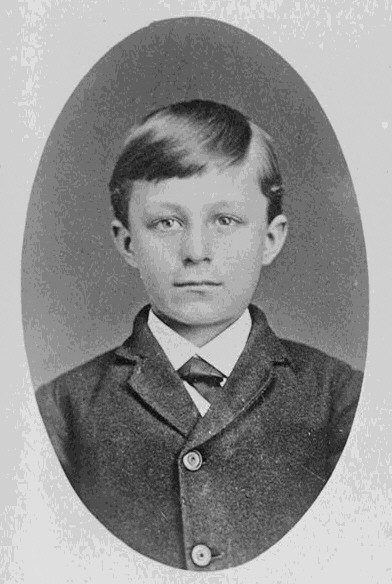
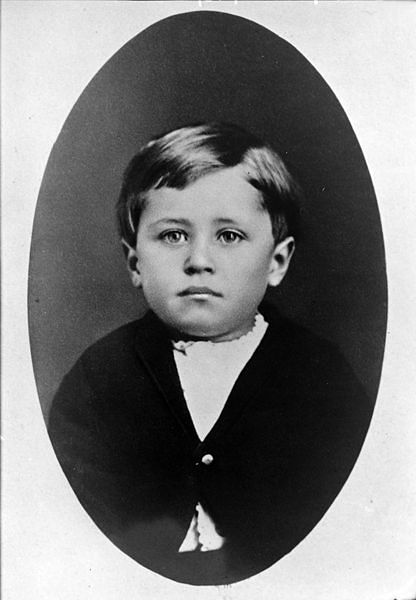
Wilbur attended high school, though he didn’t graduate due to a family move his final year. And in late 1885 or early 1886, Wilbur was struck in the face with a hockey stick while ice-skating with friends, and lost his two front teeth. Though this was not a serious physical injury, Wilbur became withdrawn, canceling his plans to attend Yale, and instead staying home. He cared for his mother, terminally ill with tuberculosis, helped his father with church work, and read extensively from his father’s library.
Orville, meanwhile, dropped out of high school in 1889, during his junior year, to start a printing business. With Wilbur’s help, he designed and built a printing press. Wilbur joined the business, and they began distributing a weekly paper, The West Side News. In April 1890, they converted it to a daily paper, The Evening Item, which ran for only four months.
Looking for their next business, in December 1892 the Wright Brothers decided to cash in on the new bicycle craze, and opened a bicycle repair shop, the Wright Cycle Exchange (later the Wright Cycle Company). In 1896 they even began building and selling their own bicycle design. That same year, three events happened that re-awoke the spark of aviation in the brothers, and began fanning that spark into a fire. In May 1896, Samuel Langley, the Smithsonian Institution Secretary, successfully flew his fixed wing model of the Aerodrome, powered by a steam engine. A couple months later, Octave Chanute, a Chicago engineer and aviation authority, started testing gliders over the sand dunes running along the shores of Lake Michigan. And in August, Otto Lilienthal had his fateful, deadly glider crash.
The Wright Brothers Glide into Aviation
In 1899, after raising additional capital with their bicycle business, the Wright Brothers decided it was the right time to get to work. In May, Wilbur wrote the Smithsonian Institution, requesting research, information and publications in the field of aeronautics. Armed with material from Leonardo da Vinci, Sir George Cayley, Chanute, Lilienthal and Langley, the brothers began their own research and experimentation.
In spite of Lilienthal’s fate, the Wright Brothers felt that mastering control with gliding was the right first step, before moving on to powered flight. In October 1899, British aeronaut Percy Pelcher plunged 30 feet after the tail broke mid-flight on his glider, and died two days later from his injuries. This only convinced the Wright Brothers that a reliable method of pilot control was necessary for successful and safe flight. Focusing on Lilienthal’s work, they decided his method of shifting body weight for balance and control wasn’t sufficient.
Wilbur, observing birds in flight, came to the conclusion that they were able to roll to the right or left in flight by making small changes to the angle at the tips of their wings. He decided this would also be a good way to control turning with a machine. The Wright Brothers worked on how to achieve this effect, eventually having a break through moment one afternoon in the shop. Wilbur sat idly twisting a long inner-tube box from their bicycle business, and observing the changes on the surface of the box, when he realized the same principle could possibly be applied to a wing. This eventually led to the development of ‘wing warping’.
Wilbur then put wing warping to the test, building a small biplane kit with a five-foot wingspan. By using four cords attached to the plane which ran to a pair of sticks held by the pilot, Wilbur was able to warp, or twist, one end of the wing. This caused that wing to produce more lift than the opposite wing, which now produced less. The plane would then bank left or right, turning in the direction of the lower wing.
In 1900, armed with additional testing and research time, the Wright Brothers settled on Kitty Hawk, North Carolina as the place to begin testing their glider. During correspondence with Octave Chanute, this location had been recommended for both regular breezes, and a soft, sandy surface for landing. Wilbur also poured over data from the US Weather Bureau, which backed up Chanute’s recommendation. Finally, Kitty Hawk was remote, which meant that the Wright Brother’s would have privacy and distance from reporters, who had created something of a circus during Chanute’s glider tests on the shores of Lake Michigan.
From 1900 through 1902, the Wright Brothers traveled to Kitty Hawk frequently to perform a series of test flights using gliders.
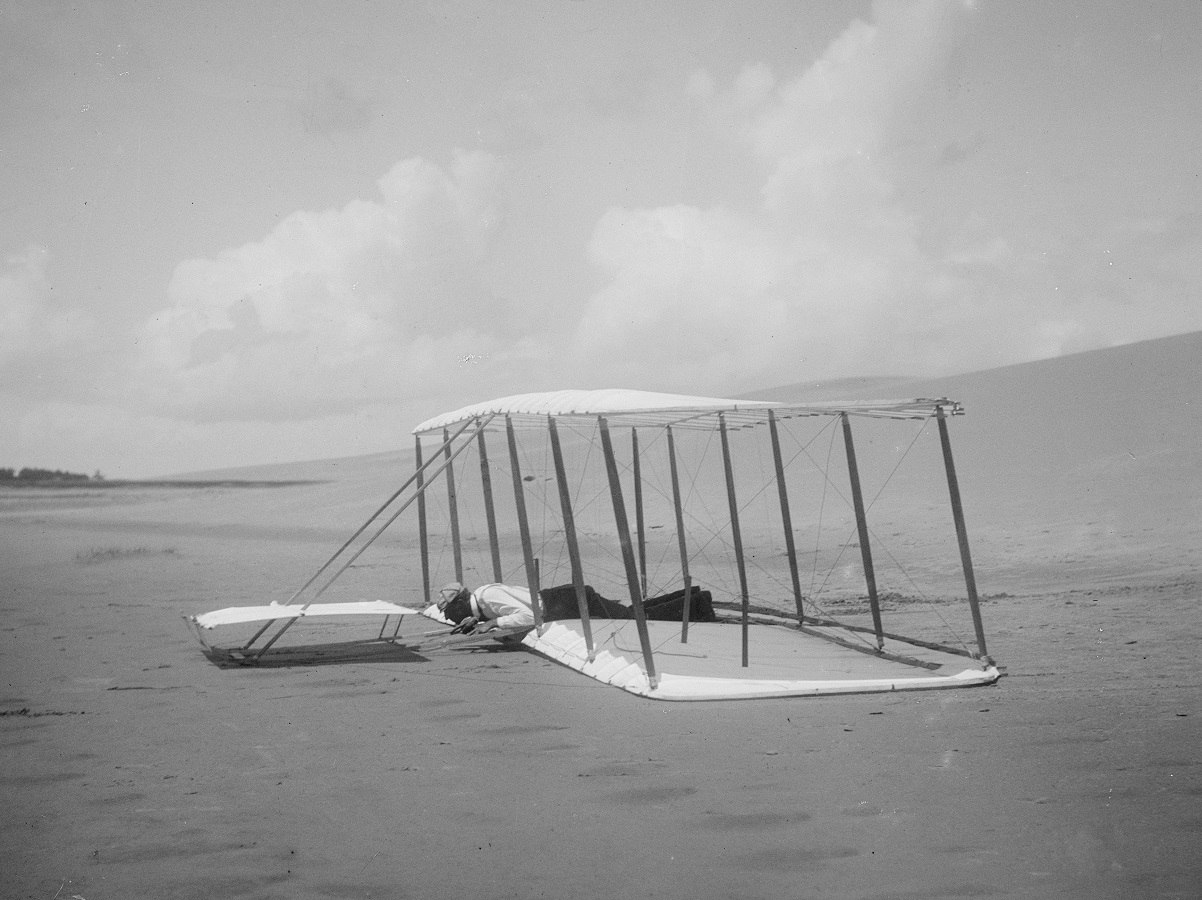
Basing their initial design on work done by Chanute, Lilienthal, and Cayley, the Wright Brothers continued to modify their glider design as they flew1. Initially, they mounted the horizontal elevator in front of the wings, instead of behind, believing that this modification would help them avoid a nosedive crash like the one that had claimed Lilienthal. Wilbur, also believing that a tail wasn’t necessary, did not build one on either of the first two gliders2. Here are the specs on the first three gliders designed by the Wright Brothers:
Wright Brothers Glider Specs
| Year | Wingspan | Wing Area | Chord | Camber | Aspect Ratio | Length | Weight |
| 1900 | 17 ft 6 In (5.33 m) | 165 sq ft (15 m2) | 5 ft (1.5 m) | 1/20 | 3.5:1 | 11 ft 6 in (3.51 m) | 52 lb (24 kg) |
| 1901 | 22 ft (7 m) | 290 sq ft (27 m2) | 7 ft (2.1 m) | 1/12, 1/19 | 3:1 | 14 ft (4.3 m) | 98 lb (44 kg) |
| 1902 | 32 ft 1 in (9.78 m) | 305 sq ft (28 m2) | 5 ft (1.5 m) | 1/20-1/24 | 6.5:1 | 17 ft (5.2 m) | 112 lb (51 kg) |
On 18 September 1901, Wilbur traveled to Chicago, at Chanute’s invitation, to present a lecture to the Western Society of Engineers. He gave a detailed speech on the glider tests from 1900-1901, and presented several photographs. This was the first public account the Wright Brothers gave on their experiments. During this time period, they also began extensive testing of wing designs in their bicycle shop, using a home-made six foot wind tunnel. By 1902, the Wright Brothers had also added a fixed rear rudder to combat adverse yaw. They soon modified the rudder to be movable and controllable by the pilot to better aid in returning to level flight after a turn.
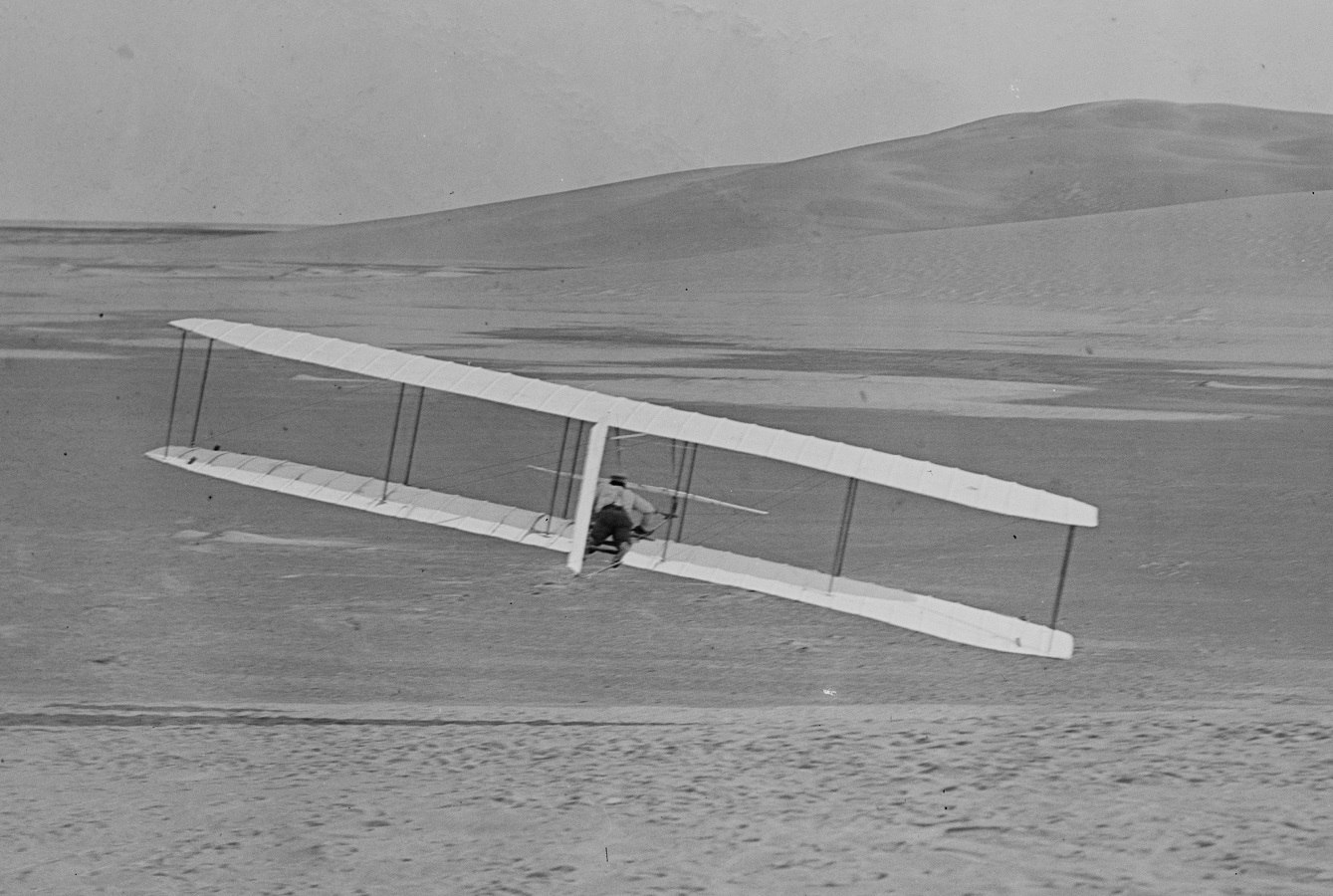
The Wright Brothers had successfully developed a three axis control system: wing-warping for roll, a forward elevator for pitch, and a rear rudder for yaw. This new design allowed them true control, and from September 19 to October 24, the Wright Brothers made between 700 and 1,000 successful glides. The longest recorded glide during this period lasted 26 seconds and covered 622.5 feet (189.7 m).
The Wright Brothers Set Their Sights on Powered Flight
It was after this series of successful glides that the Wright Brothers decided they were ready to tackle powered flight. They began construction of the Wright Flyer 1 in 1903. They built the airframe from spruce and used muslin fabric to cover the control surfaces. Finding no reliable propeller designs to adapt from shipbuilding, the Wright Brothers had to design their own. Deciding that a propeller was basically a wing rotating on a vertical plane, they tested various shapes in their wind tunnel. The finished propeller blades, made by gluing three layers of spruce together and then laminating them, were eight feet long. Rather than a single, slower propeller, the Wright Brothers decided using a pair of pusher propellers, counter-rotating to cancel torque, would act on a greater quantity of air3.
Finally, it was time to fit the Wright Flyer 1 with an engine. The Wright Brothers contacted several engine manufacturers, but no one could provide them with an engine that would be light enough for their needs. So, they turned to their bicycle shop mechanic Charlie Taylor. Under their supervision, Taylor was able to build an engine in just six weeks, casting the engine block from aluminum to keep the weight down. There was no fuel pump on the engine. Gasoline was gravity fed from a fuel tank mounted on a wing strut into a chamber on the engine next to the cylinders. Here, the fuel was mixed with air and the mixture was vaporized by heat from the crankcase and forced into the cylinders, which powered heavy duty propeller drive chains.
The Wright Flyer 1 was ready, and at a cost of less than $1,000. This was remarkably cost efficient compared to other flying machines of the time, such as Langley’s Aerodrome, which had cost more than $50,000.
Wright Flyer 1 Specs:
Crew: One
Length: 21 ft 1 in (6.43 m)
Wingspan: 40 ft 4 in (12.31 m)
Height: 9 ft 0 in (2.74 m)
Wing area: 510 ft² (47 m²)
Empty weight: 605 lb (274 kg)
Max. takeoff weight: 745 lb (338 kg)
Powerplant: 1 × straight-4 water-cooled piston engine, 12 hp (9 kW), 170 lbs (77.3 kg), (2 Wright “Elliptical” props, 8ft. 6in., port prop carved to counter-rotate left, starboard prop carved to rotate to the right)
Performance
Maximum speed: 30 mph (48 km/h)
Service ceiling: 30ft (9m)
Wing loading: 1.4 lb/ft² (7 kg/m²)
Power/mass: 0.02 hp/lb (30 W/kg)
The Wright Brothers Test the Wright Flyer 1
Ready to test their new machine, the Wright Brothers were delayed by a series of broken propeller shafts during engine testing. Finally, on 14 December 1903, they were ready. Wilbur, winning a coin toss, made the first attempted flight. It lasted only three seconds, stalling after takeoff. The Flyer sustained minor damage, and the Wright Brothers set about repairing it. They were ready again on 17 December 1903, deciding to fly despite a frigid 27 mph headwind. Orville was first this time (I guess he won the coin-toss), taking off at 10:35 AM. He traveled 120 feet (37 m) in 12 seconds at a speed of 6.8 mph (10.9 kph). The flight was captured in this historic photograph by amateur photographer John T. Daniels.
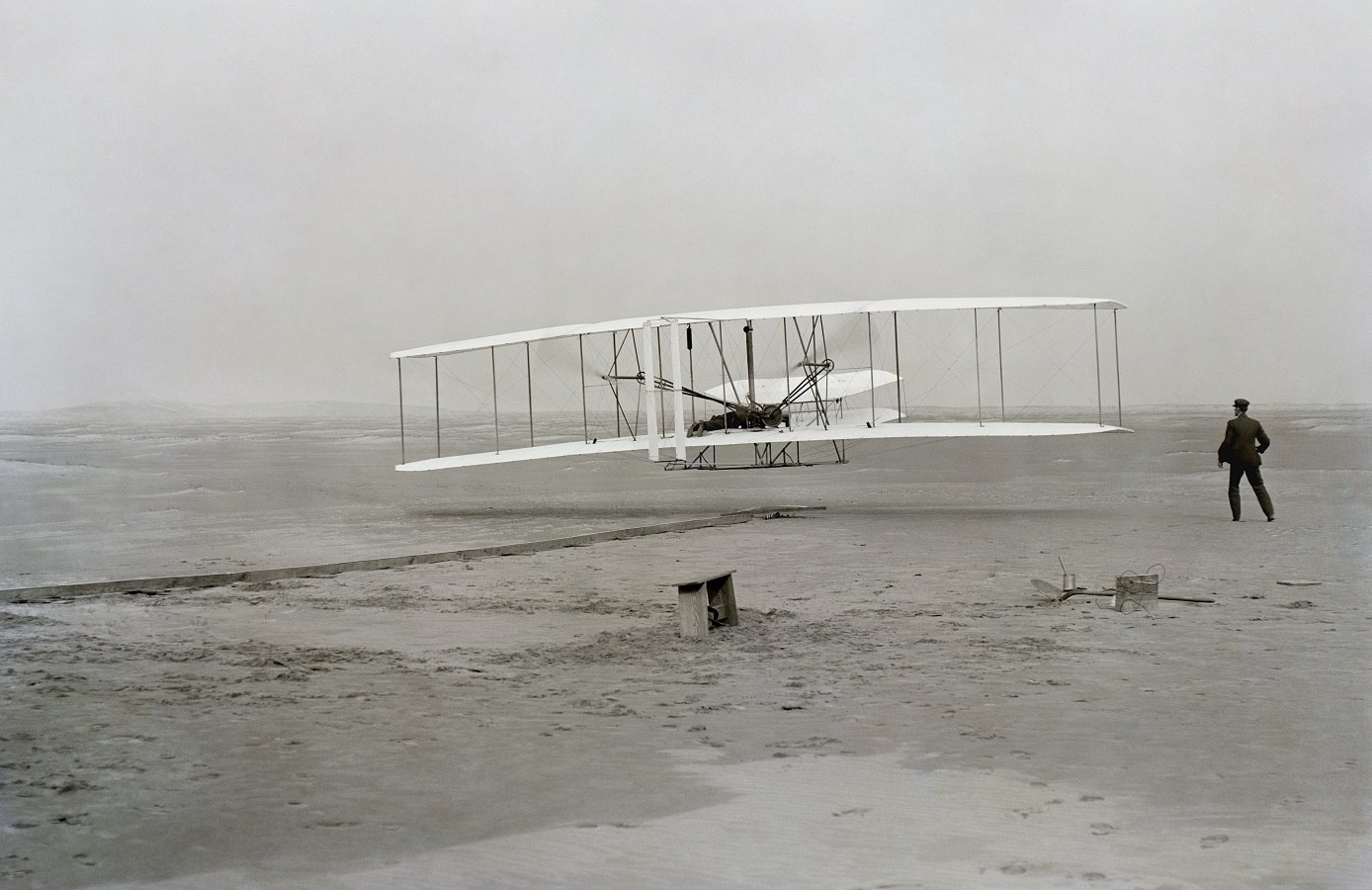
The Wright Brothers made three more flights that day, each brother flying twice. Flights two and three covered roughly 175 feet (53 m) and 200 feet (61 m) respectively, at a height of about 10 feet (3 m) off the ground. The fourth and final flight turned out to be the most spectacular, and was detailed by Orville:
“Wilbur started the fourth and last flight at just about 12 o’clock. The first few hundred feet were up and down, as before, but by the time three hundred feet had been covered, the machine was under much better control. The course for the next four or five hundred feet had but little undulation. However, when out about eight hundred feet the machine began pitching again, and, in one of its darts downward, struck the ground. The distance over the ground was measured to be 852 feet; the time of the flight was 59 seconds. The frame supporting the front rudder was badly broken, but the main part of the machine was not injured at all. We estimated that the machine could be put in condition for flight again in about a day or two.”
In addition to Orville, Wilbur, and John T. Daniels, four other people were present for the first flight: Adam Etheridge and Will Dough (working for the US Government), WC Brinkley (a businessman from the area) and local teenager Johnny Moore.
After the fourth flight, as the men hauled the Flyer back to camp, a strong gust picked the Flyer up and, despite efforts to hold it down, flipped it over several times, splitting the engine block in half and severely damaging the airframe. Photographer John T. Daniels, who had grabbed a strut in an attempt to hold the Flyer down, was caught between the wings as the Flyer flipped end over end. He escaped without serious injury, and for the rest of his life would regale any who would listen with the story of how he survived “the world’s first airplane crash.” The Wright Flyer 1 never flew again, though Orville eventually restored it for display in a museum.
After the years following this flight, the Wright Brothers tested and further refined their designs, continued giving public demonstrations in the US and Europe, engaged in a lengthy and litigious patent war with Glenn Curtiss and other early aviators, and feuded with the Smithsonian (which naturally supported Samuel Langley) over who should receive credit for the first powered flight. All of those events are, by themselves, worthy of their own accounting. I’ll discuss the result of the feud with the Smithsonian a little more in First Flight: Gustave Whitehead, when it intersects with Whitehead’s story. But before we finish up this section on the Wright Brothers, and move on to Whitehead and the others, there is one final interesting note regarding Wilbur and Orville to consider.
Were the Wright Brothers Equal?
The Wright Brothers always presented an equal, united public image. They shared equal credit for their inventions and innovations, but many Wright biographers feel that this is not entirely accurate. Generally, older brother Wilbur is accepted as being the innovator and thinker, with younger brother Orville playing more the role of the assistant. Starting in 1899, Wilbur appears to have taken the initiative to change this perception and unify their image when he stopped writing of ‘my’ machine and ‘my’ plans, and began using ‘we’ and ‘our’. According to James Tobin, author of To Conquer the Air: The Wright Brothers and the Great Race for Flight (which you can find here):
“It is impossible to imagine Orville, bright as he was, supplying the driving force that started their work and kept it going from the back room of a store in Ohio to conferences with capitalists, presidents, and kings. Will did that. He was the leader, from the beginning to the end.”
In 1912, after battling typhoid fever for several weeks, Wilbur Wright died on May 30th. Orville, after managing the business for a couple of years, sold the company in 1915. He made his last flight in 1918, eventually retiring completely from business and active research. He maintained his link to aviation through serving on various boards and committees, but these actions would seem to support the idea that Wilbur was the driving force behind the Wright Brothers and their quest for powered first flight.
Footnotes:
1 – Chanute visited the Wright Brothers multiple times during these glider tests, though he was not present for their first powered flight in December 1903.
2 – It’s also interesting to note that most Wright Brothers historians believe that Wilbur handled all the gliding duties until at least 1902, most likely to protect his brother Orville from harm.
3 – Wilbur wrote in a logbook that these initial propellers were 66% efficient. Modern testing of the design places it at 75% efficient, an astounding number for the time.










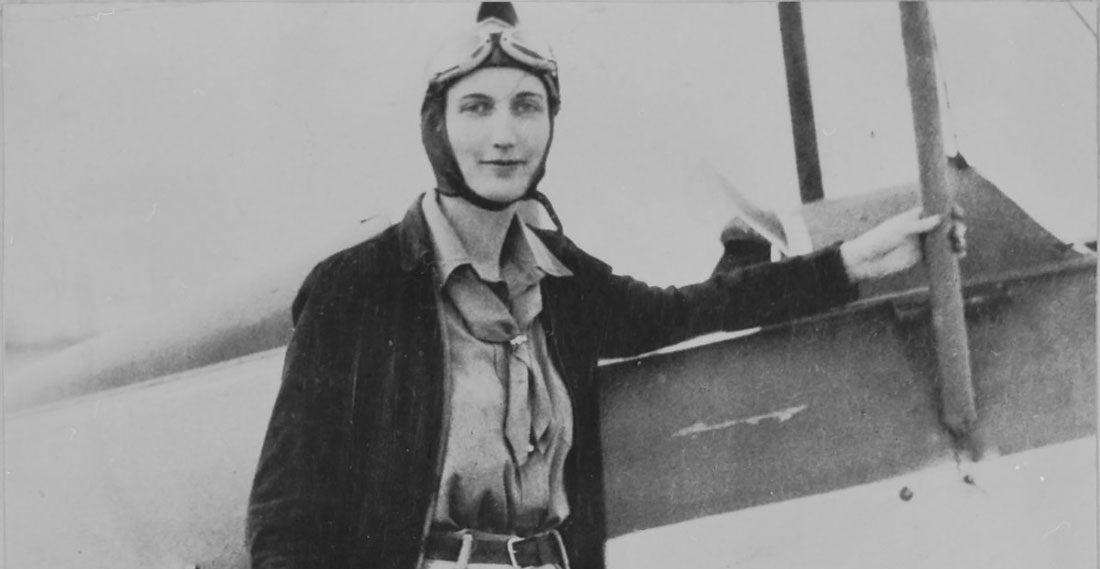



Leave a Reply